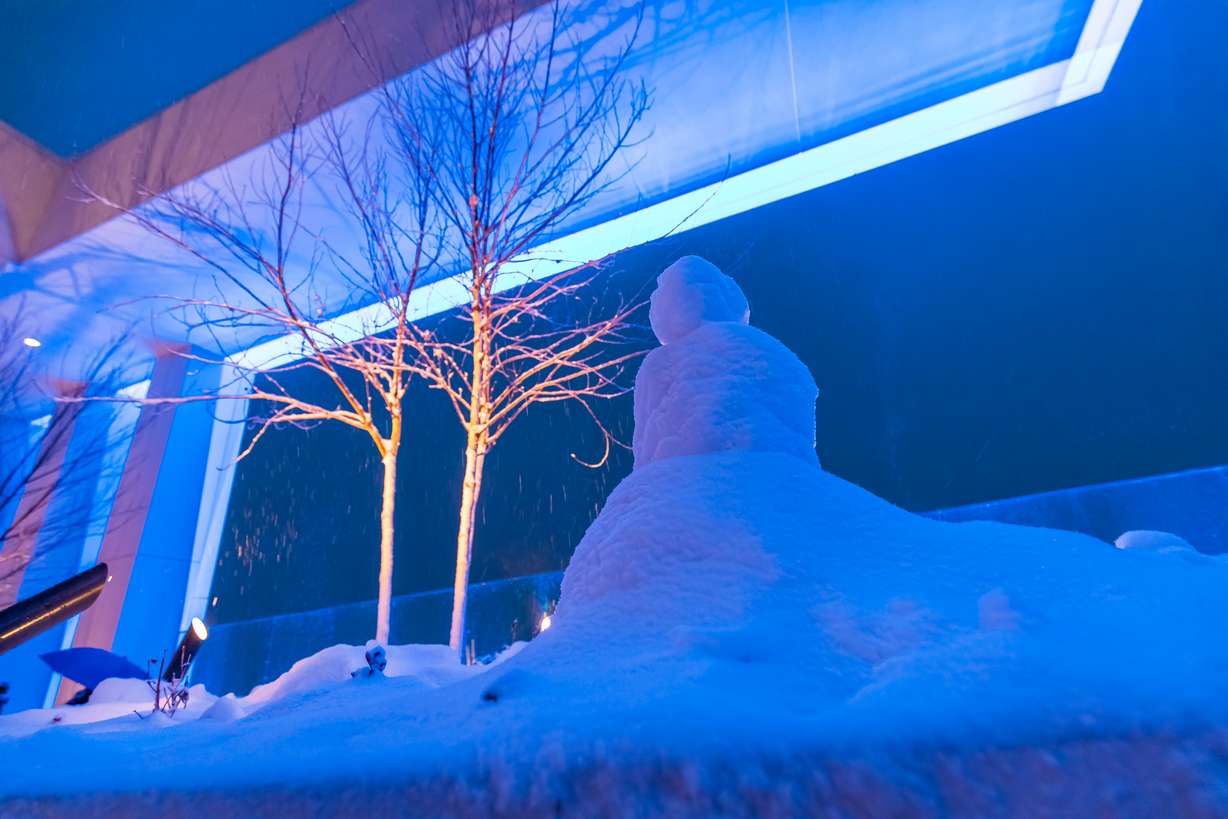Estimated read time: 4-5 minutes
- Astra Tower in Salt Lake City now features a unique air quality beacon.
- The tower's lights change colors to indicate air quality levels, promoting awareness.
- Local leaders hope it becomes an educational and inspirational tool for air quality changes.
SALT LAKE CITY — Shane Rensmon could have waxed poetic about the Astra Tower, but he kept his words short as wind-fueled snow battered him and a crowd gathered at the top of the city's tallest building to witness the newest feature.
Moments later, Rensmon, president of real estate development for Kensington Investment Company, the building's owner and a group of state, county and city leaders huddled together to press a ceremonial button that illuminated the outdoor patio blue around them.
The dazzling colors that left the group in awe is a one-off color scheme, used Thursday to better demonstrate the building's lights through the snow. Ideally, the top of the tower will remain white because it will signal that good or moderate air quality is in Salt Lake County's forecast the next day.
Its lights will turn to orange, red or purple when projected air quality index scores worsen to unhealthy for sensitive groups, unhealthy and very healthy levels. It'll be lit to special colors during holidays like other downtown buildings with similar auxiliary lights, but its default setting is an air quality weather forecast beacon just like the top of the Walker Center about a block west of it.
And both Rensmon and Lindsie Smith, executive director of the Utah Clean Air Partnership, hope that the new lighting feature will help the Astra Tower become as beloved as its neighbor.
"We are hoping that Astra Tower becomes an icon in downtown Salt Lake City, and people can look to the tower to know, how is our air quality is looking in the valley?" she said. "(People can) use it as an educational tool and an inspirational tool."

UCAIR officials announced their plans for the first-of-its-kind air quality monitoring beacon earlier this month. While air quality has improved over the past few decades, Smith says there's still work to do. That's where she believes the Astra Tower can help.
The 451-foot building opened last year, reshaping the city's skyline. Some of its features were recently completed, such as the swanky patio at its top that opened up to residents for the first time earlier this month.
The building itself was designed to receive LEED golf certification from the U.S. Green Building Council. It was constructed with "locally sourced" materials arriving within a 500-mile radius of the project, Rensmon said. It also features air scrubbers that filter air as it comes in and out, and it's about 99% electric with some gas fireplaces for common areas in the building.
He and Smith — at some point — connected on a plan to turn the top of the building into an air quality forecast beacon to add to everything. They had considered using the same scale as the air quality network, but he jokes that it might make people think it's St. Patrick's Day every day.

That's when they agreed on a four-color system. Smith says she would like people to take action once the skyline turns orange, working remotely, using transit or chaining trips to reduce emissions that get trapped in the atmosphere during inversion or ozone events.
Salt Lake City Mayor Erin Mendenhall said people can also bike to work, although perhaps not on days like Thursday, which prompted her to cancel a "Bike to Work" event earlier in the day. Last year, 800 new electric lawn equipment pieces were handed to residents who traded in their gas engine versions through a city program, as well.
"We can all do something; we all have to lean in and take action," Rensmon said. "The idea is the Astra Tower will bring that awareness. ... People are reminded when they drive home from work or drive into work."
State representatives hope it can also start conversations over new air quality policies. Rep. Paul Cutler, R-Centerville, said the Utah Legislature is looking to take on reducing heavy-duty truck pollution through a bill he introduced earlier this week. Another bill introduced this week looks to clamp down on emissions from magnesium mining operations by the Great Salt Lake.
Yet, Rep. Jennifer Dailey-Provost, D-Salt Lake City, believes legislation alone won't solve the problem.
"It's an important piece of the puzzle, but we have a great opportunity to empower every person to meet those (air quality) needs the best way that they can," she said, explaining that state government is typically more "reactionary" to issues. "We can't just outlaw bad air."
At least residents can now look to the downtown skyline to know when bad air arrives.









